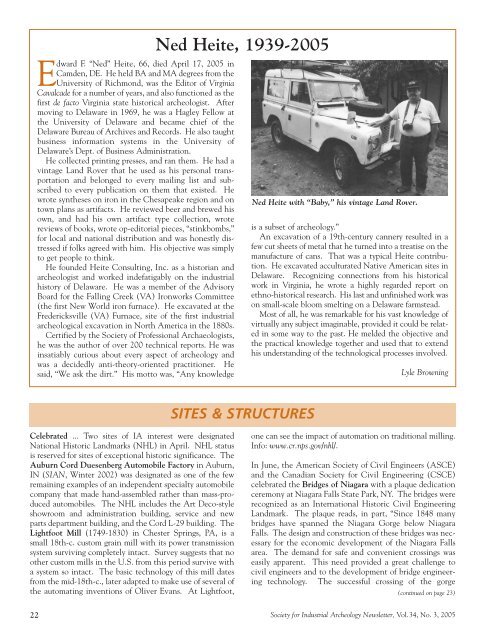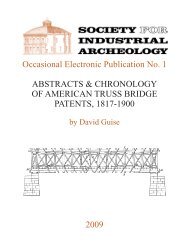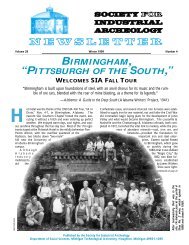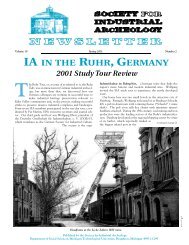SIAN - Society for Industrial Archeology
SIAN - Society for Industrial Archeology
SIAN - Society for Industrial Archeology
Create successful ePaper yourself
Turn your PDF publications into a flip-book with our unique Google optimized e-Paper software.
Edward F. “Ned” Heite, 66, died April 17, 2005 in<br />
Camden, DE. He held BA and MA degrees from the<br />
University of Richmond, was the Editor of Virginia<br />
Cavalcade <strong>for</strong> a number of years, and also functioned as the<br />
first de facto Virginia state historical archeologist. After<br />
moving to Delaware in 1969, he was a Hagley Fellow at<br />
the University of Delaware and became chief of the<br />
Delaware Bureau of Archives and Records. He also taught<br />
business in<strong>for</strong>mation systems in the University of<br />
Delaware’s Dept. of Business Administration.<br />
He collected printing presses, and ran them. He had a<br />
vintage Land Rover that he used as his personal transportation<br />
and belonged to every mailing list and subscribed<br />
to every publication on them that existed. He<br />
wrote syntheses on iron in the Chesapeake region and on<br />
town plans as artifacts. He reviewed beer and brewed his<br />
own, and had his own artifact type collection, wrote<br />
reviews of books, wrote op-editorial pieces, “stinkbombs,”<br />
<strong>for</strong> local and national distribution and was honestly distressed<br />
if folks agreed with him. His objective was simply<br />
to get people to think.<br />
He founded Heite Consulting, Inc. as a historian and<br />
archeologist and worked indefatigably on the industrial<br />
history of Delaware. He was a member of the Advisory<br />
Board <strong>for</strong> the Falling Creek (VA) Ironworks Committee<br />
(the first New World iron furnace). He excavated at the<br />
Fredericksville (VA) Furnace, site of the first industrial<br />
archeological excavation in North America in the 1880s.<br />
Certified by the <strong>Society</strong> of Professional Archaeologists,<br />
he was the author of over 200 technical reports. He was<br />
insatiably curious about every aspect of archeology and<br />
was a decidedly anti-theory-oriented practitioner. He<br />
said, “We ask the dirt.” His motto was, “Any knowledge<br />
Celebrated ... Two sites of IA interest were designated<br />
National Historic Landmarks (NHL) in April. NHL status<br />
is reserved <strong>for</strong> sites of exceptional historic significance. The<br />
Auburn Cord Duesenberg Automobile Factory in Auburn,<br />
IN (<strong>SIAN</strong>, Winter 2002) was designated as one of the few<br />
remaining examples of an independent specialty automobile<br />
company that made hand-assembled rather than mass-produced<br />
automobiles. The NHL includes the Art Deco-style<br />
showroom and administration building, service and new<br />
parts department building, and the Cord L-29 building. The<br />
Lightfoot Mill (1749-1830) in Chester Springs, PA, is a<br />
small 18th-c. custom grain mill with its power transmission<br />
system surviving completely intact. Survey suggests that no<br />
other custom mills in the U.S. from this period survive with<br />
a system so intact. The basic technology of this mill dates<br />
from the mid-18th-c., later adapted to make use of several of<br />
the automating inventions of Oliver Evans. At Lightfoot,<br />
Ned Heite, 1939-2005<br />
SITES & STRUCTURES<br />
Ned Heite with “Baby,” his vintage Land Rover.<br />
is a subset of archeology.”<br />
An excavation of a 19th-century cannery resulted in a<br />
few cut sheets of metal that he turned into a treatise on the<br />
manufacture of cans. That was a typical Heite contribution.<br />
He excavated acculturated Native American sites in<br />
Delaware. Recognizing connections from his historical<br />
work in Virginia, he wrote a highly regarded report on<br />
ethno-historical research. His last and unfinished work was<br />
on small-scale bloom smelting on a Delaware farmstead.<br />
Most of all, he was remarkable <strong>for</strong> his vast knowledge of<br />
virtually any subject imaginable, provided it could be related<br />
in some way to the past. He melded the objective and<br />
the practical knowledge together and used that to extend<br />
his understanding of the technological processes involved.<br />
Lyle Browning<br />
one can see the impact of automation on traditional milling.<br />
Info: www.cr.nps.gov/nhl/.<br />
In June, the American <strong>Society</strong> of Civil Engineers (ASCE)<br />
and the Canadian <strong>Society</strong> <strong>for</strong> Civil Engineering (CSCE)<br />
celebrated the Bridges of Niagara with a plaque dedication<br />
ceremony at Niagara Falls State Park, NY. The bridges were<br />
recognized as an International Historic Civil Engineering<br />
Landmark. The plaque reads, in part, “Since 1848 many<br />
bridges have spanned the Niagara Gorge below Niagara<br />
Falls. The design and construction of these bridges was necessary<br />
<strong>for</strong> the economic development of the Niagara Falls<br />
area. The demand <strong>for</strong> safe and convenient crossings was<br />
easily apparent. This need provided a great challenge to<br />
civil engineers and to the development of bridge engineering<br />
technology. The successful crossing of the gorge<br />
(continued on page 23)<br />
22 <strong>Society</strong> <strong>for</strong> <strong>Industrial</strong> <strong>Archeology</strong> Newsletter, Vol.34, No. 3, 2005






